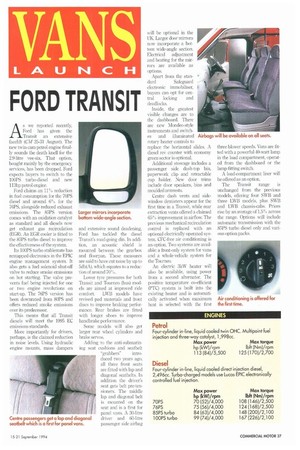FORD TRANSIT
Page 39

If you've noticed an error in this article please click here to report it so we can fix it.
As we reported recently, Ford has given the Transit an extensive facelift (CM 25-31 August). The new twin-cam petrol engine finally sounds the death knell for the 2.9-litre vee-six. That option, bought mainly by the emergency services, has been dropped. Ford expects buyers to switch to the 100PS turbo-diesel and new 1131ip petrol engine.
Ford claims an 11% reduction in fuel consumption for the 70PS diesel and around 6% for the 76PS, alongside reduced exhaust emissions. The 85PS version comes with an oxidation catalyst as standard and all diesels now get exhaust gas recirculation (EGR). An EGR cooler is fitted to the 85PS turbo diesel to improve the effectiveness of the system.
Its 100PS turbo stablemate has rernappeel electronics in the EPIC engine management system. It also gets a fuel solenoid shut-off valve to reduce smoke emissions on hot starting. The valve prevents fuel being injected for one or two engine revolutions on start-up. The 76PS version has been downrated from 80PS and offers reduced smoke emissions over its predecessor.
This means that all Transit diesels will meet the 1995 EC emissions standards.
More importantly for drivers, perhaps, is the claimed reduction in noise levels. Using hydraulic engine mounts, mass dampers and extensive sound deadening, Ford has tackled the diesel Transit's road-going din. In addition, an acoustic shield is mounted between the gearbox and fioorpan. 'These measures are said to have cut noise by up to 5c1b(A), which equates to a reduction of around 70%.
Lower tyre pressures for both Transit and Tourneo (bus) models are aimed at improved ride comfort. LWB models have revised pad materials and front discs to improve braking performance. Rear brakes are fitted with longer shoes to improve handbrake performance.
Some models will also get larger rear wheel cylinders and brake servos.
Adding to the anti-submarining seat cushions and seatbelt
grabbers" introduced two years ago, all three front seats are fitted with lap and diagonal seatbehs. In addition the driver's seat gets belt pre-tensioners. The middle lap and diagonal belt is mounted on the seat and is a first for panel vans. A 30-litre driver and 60-litre passenger side airbag
will be optional in the UK. Larger door mirrors now incorporate a bottom wide-angle section. Electrical adjustment and heating for the mirrors are available as options.
Apart from the stan dard Safeguard electronic immobiliser, buyers can opt for cen tral locking and deadlocks.
Inside, the greatest visible changes are to the dashboard. There are new Mondeo-style instruments and switches and illuminated rotary heater controls to replace the horizontal slides. A diesel rev counter with economy green sector is optional.
Additional stowage includes a passenger side dash-top bin, paperwork clip and retractable cup holder. New door trims include door speakers, bins and inouldal armrests.
Centre dash vents and side. window demisters appear for the first time in a Transit, while rear extraction vents offered a claimed 65% improvement in airflow. The previous mechanical recirculation control is replaced with an optional electrically operated system. CFC-free air conditioning is an option. Two systems are available: a front-only system for vans and a whole-vehicle system for the Tournea An electric 3kW heater will also be available, using power from a second alternator. The positive temperature co-efficient (PTC) system is built into the existing heater and is automatically activated when maximum heat is selected with the first three blower speeds. Vans are fitted with a powerful 40-watt lamp in the load compartment, operated from the dashboard or the lamp fitting switch.
A load-compartment liner will be offered as an option.
The Transit range is unchanged from the previous models, offering four SWB and three LWB models, plus SWB and 1,WB chassis-cabs. Prices rise by an average of 1.5% across the range. Options will include automatic transmission with the 8,-SPS turbo diesel only and vanOtis option packs.
































































































